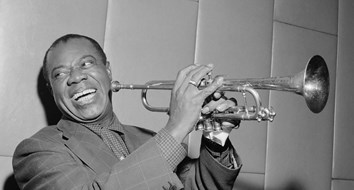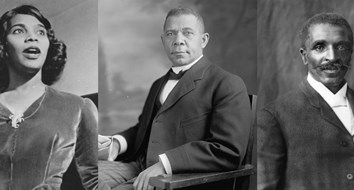Download:
More than 150 years ago Karl Marx predicted that communism was inevitable. History, he claimed, was marching inexorably toward a communist paradise. In hindsight it would appear that if anything about communism was inevitable, it was that it would sooner or later be relegated to the status of museum relic. In the capital city of a formerly communist country in eastern Europe, that’s exactly what has happened.
Visit Prague in the Czech Republic these days and there’s a spot you won’t want to miss. It’s the Museum of Communism, amidst the city’s main shopping district and just a five-minute walk from the foot of beautiful Wenceslaus Square. Advertisements around town tell the tourist where to find it and reveal a little irony too: “We’re Above McDonald’s, Across from Benetton, Viva La Imperialism!” A lively casino occupies the adjacent building.
While in Prague last August I stumbled into the museum with no expectations of its perspective. Was it sponsored by allies of the ancien régime, nostalgic for the “good old days” and eager to whitewash the past? Or would it be honest about the country’s painful, 40-year experience with a failed ideology? Fortunately, this place tells the truth.
The man behind the museum is not himself a native Czech. He is Glenn Spicker, a 38-year-old American entrepreneur who was attracted to Prague’s new business opportunities after the 1989 “Velvet Revolution” expelled the communists from power. He introduced bagels to Prague and opened a jazz club and several successful restaurants. It soon struck him that what was missing in the city was any vivid public reminder of what life was like before 1989. So he spent several months and $28,000 searching flea markets and junk shops for almost a thousand bits and pieces of Red memorabilia—including busts of Marx and Lenin, textbooks, posters, and samples of the shoddy merchandise that once adorned dingy state-owned storefronts all across the country. The museum opened its doors in December 2001.
Exhibits that explain the communist “dream” greet the visitor first upon entering. Slogans, propaganda, and all the paraphernalia of promises made to be broken remind one of the wildly utopian vision once offered by Marx and his followers. Communist theoreticians boasted that they would produce an egalitarian “workers’ paradise” of happiness and abundance, but nothing of the sort came to pass in eastern Europe or anywhere else the system was tried. The largest portion of Spicker’s museum is dedicated to portraying the reality of the communist “nightmare”—an Orwellian trap where private hardship was the rule behind all the public smiles.
Prague is often called the Paris of Eastern Europe for its open and lively city life, stately architecture, rich musical heritage, and cultural diversity. Tourists marvel at the art and entrepreneurship evident on every block. Czechs smile and make friends quickly. Just 15 years since liberation, it’s easy to forget how tyranny once kept these same people in thralldom.
In Spicker’s museum the reconstruction of an interrogation room used by the secret police provides a chilling refresher in state terror. Records show that under communist rule Czech political dissidents were executed by the dozens; more than a quarter million were imprisoned. The secret police employed no fewer than 200,000 spies paid to keep watch over their fellow citizens.
In another corner of the museum sits a replica of a grocery storefront, shabby and unattractive because that’s the way storefronts looked under communism. Shelves were often bare or stocked with goods few people wanted. Shoppers had to endure long lines to secure the most basic of commodities. An inscription tells the visitor that price controls led to a thriving black market in which “poorly paid employees of the shops hid rare merchandise for selected customers, who were able to pay some extra money or provide a certain counter-service.” Much of Czech society resorted to simple barter: “the butcher exchanged his steaks for bananas from the grocer,” for example.
Ecological Disaster
Did communist central planners nurture the natural environment? Hardly. Everywhere communists were in charge—from the Soviet Union and its satellites to mainland China—ecological disaster ensued. The Prague museum explains: “Surface mining in Northern Bohemia changed extensive areas of land into wasteland and the use of solid fuel in power stations polluted the air and killed border forests. Attempts to increase the yield in collectivized agriculture with the application of industrial fertilizers and heavy mechanization led to extensive damage of soil and underground water. This led to the elimination and extermination of a large number of small wildlife species. The statistics show that the average age of inhabitants of communist countries was considerably lower than the average age in the democratic countries. After the fall of communism in the Czech Republic the average age of citizens rapidly increased by about five years.”
Though the story the museum is designed to tell is grim, Spicker does have a sense of humor. To help raise money to pay the bills, the museum gift shop offers postcards and poster-size reproductions of communist-era propaganda photos but each with an added caption. One depicts a peasant woman holding aloft in the breeze a piece of cloth. The caption reads, “You couldn’t get laundry detergent, but you could get your brain washed.” Another shows a parade of smiling teens waving red flags below these words: “It was a time of happy, shiny people. The shiniest were in the uranium mines.”
Near the museum exit stands a portion of the Berlin Wall, still adorned with the graffiti that Westerners scrawled on the free side of that despicable barrier. Among the scribblings are these poignant words large enough that no visitor can miss: “Let me live my life, enjoy freedom, touch the limits, reach the stars, understand the world. That’s what I want.”
Communism was one of history’s most infamous lies. What it wrought stands as a horrible testament to the “planned chaos” of the omnipotent state. The truth demands that its record be documented and displayed. Glenn Spicker’s museum does precisely that, for which men and women everywhere should be grateful.
(Editor’s note: Readers can sample the museum’s offerings by visiting its English-language website, www.muzeumkomunismu.cz.)





